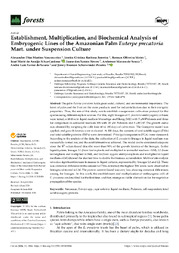Establishment, multiplication, and biochemical analysis of embryogenic lines of the Amazonian palm Euterpe precatoria Mart. under suspension culture.
Establishment, multiplication, and biochemical analysis of embryogenic lines of the Amazonian palm Euterpe precatoria Mart. under suspension culture.
Author(s): VASCONCELOS, A. D. M.; FERREIRA, J. C. B.; MEIRA, R. O.; SILVA-CARDOSO, I. M. de A.; NEVES, J. dos S.; SOUZA, A. M. de; SOUZA, A. L. X. de; PEREIRA, J. E. S.
Summary: The palm Euterpe precatoria holds great social, cultural, and environmental importance. The heart of palm and the fruit are the main products used for industrialization due to their energetic properties. Thus, the aim of this study was to establish a suspension cultivation protocol for the species using different explant sources. For this, eight lineages of E. precatoria embryogenic calluses were tested, with five in liquid medium Murashige and Skoog (MS) with 5 ?M Picloram and three for comparison in semisolid medium MS with 20 ?M Picloram and 5 ?M 2iP. The growth curve was obtained by weighing the calli from 60 to 180 days of cultivation. The Gompertz model was applied, and growth kinetics were evaluated. At 100 days, the contents of total soluble sugars (TSSs) and total soluble proteins (TSPs) were determined. Principal components (PCA) were measured. According to the analysis of the data, the cultivation of E. precatoria lineages in liquid medium was successfully carried out, and the establishment was achieved. The model can be considered adequate since the R2 values found describe more than 90% of the growth kinetics of the lineages. In the liquid system, lineages L1 (from leaf explants and multiplied in semisolid medium—SM), L2 (from leaf explants and multiplied in SM), and L6 (from zygotic embryo explants and multiplied in liquid medium—LM) showed the shortest time to double the biomass accumulation. Multivariate analysis reveals a significant increase in masses in liquid cultures, represented by lineages L6 and L2. There was statistical difference in the amount of TSSs extracted; the highest TSS levels were observed in lineages cultivated in LM. The protein content found was very low, showing statistical differences among the lineages. In this work, the establishment and multiplication of embryogenic calli of E. precatoria are described for the first time, and they emerge as viable alternatives for the vegetative propagation of the species.
Publication year: 2024
Types of publication: Journal article
Observation
Some of Embrapa's publications are published as ePub files. To read them, use or download one of the following free software options to your computer or mobile device. Android: Google Play Books; IOS: iBooks; Windows and Linux: Calibre.
Access other publications
Access the Agricultural Research Database (BDPA) to consult Embrapa's full library collection and records.
Visit Embrapa Bookstore to purchase books and other publications sold by Embrapa.

